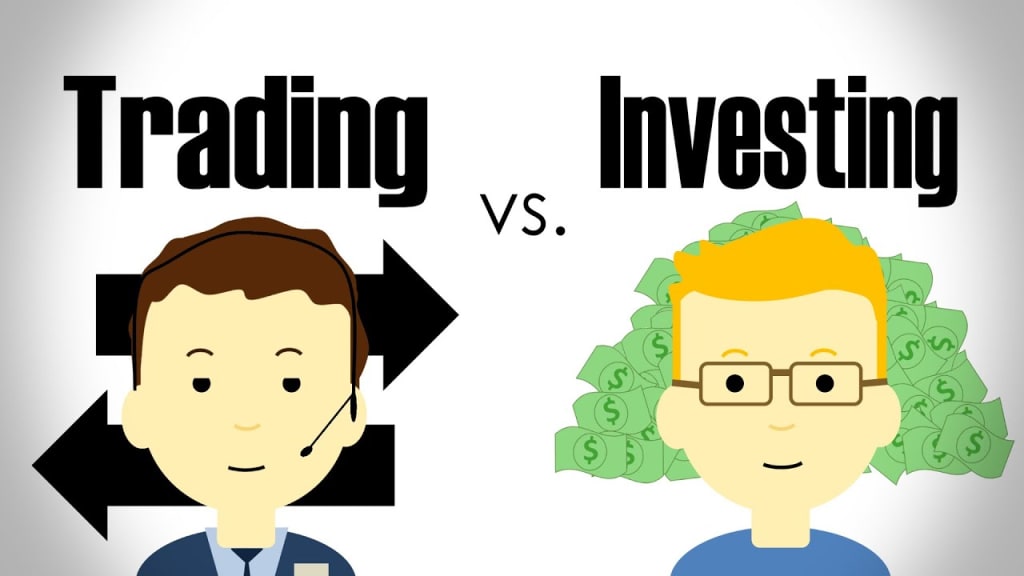Can you be a next Warren Buffett?
Trading vs Investing

Trading and investing are two popular techniques to increase your money. Making wise financial decisions requires an awareness of the differences between the two because each has benefits and drawbacks. The fundamentals of trading and investing will be covered in this article, along with some advice on how to get started.
Investing
A long-term approach called investing entails purchasing and holding assets with the intention of making money through price growth, dividends, or interest payments. By choosing assets with the potential to appreciate in value, investment aims to create wealth over time. Stocks, bonds, mutual funds, exchange-traded funds (ETFs), real estate, and other types of assets are all available to investors.
The capacity to create passive income is one of the main benefits of investing. Many stocks, bonds, and ETFs provide dividends or interest, which can give investors a consistent source of income. Additionally, investing can assist people in reaching their financial objectives, such as supporting a child's education, purchasing a home, or saving for retirement.
However, there are certain drawbacks to investing. Market volatility is one of the main dangers involved with investing. Over time, asset prices can change greatly, and investors who purchase an asset at the wrong moment or during a market collapse may suffer considerable losses. Aside from that, some investments, like real estate or particular kinds of funds, may be illiquid, which means that it may be difficult to sell them rapidly.
Benefits of investing:
1. Passive income: Purchasing dividend-paying stocks, for instance, can produce passive income.
2. Diversification: Spreading your risk and limiting losses by investing in a variety of assets.
3. Tax advantages: A few investment kinds, such retirement accounts or tax-free bonds, provide tax advantages.
Investment drawbacks:
1. Volatility: Asset values and market conditions can change dramatically over time.
2. Limited liquidity: It may be challenging to sell some investments, such as real estate or specific types of funds, rapidly.
3. Exorbitant expenses: Some investing vehicles, like mutual funds, have exorbitant fees that might reduce your profits.
Trading
A short-term approach called trading is purchasing and selling assets with the intention of quickly turning a profit. In order to find inexpensive assets, traders often use technical and fundamental analysis. They may hold positions for days, weeks, or even only a few seconds.
The possibility for large gains is one of the main benefits of trading. If they are successful, traders can make substantial profits very fast by transacting in a range of assets, such as stocks, currencies, commodities, and derivatives. Additionally, because traders can swiftly alter their holdings in response to market movements, trading may be more flexible than investing.
However, there are considerable hazards associated with trading. Trading can be incredibly volatile, and if traders make bad choices, losses can mount up quickly. Additionally, emotions like fear and greed can affect traders and cause them to make rash or foolish decisions. Finally, trading costs might be considerable, especially for traders who are active and place lots of deals.
Advantages of trading:
1. High potential returns: Successful traders can quickly generate substantial profits.
2. Flexibility: Traders are able to swiftly modify their positions in reaction to developments in the market.
3. Variety: Traders can trade a variety of assets, including as derivatives, equities, currencies, and commodities.
Negative aspects of trading:
1. High risk: Trading can carry a significant amount of risk, and losses can mount quickly.
2. Emotional decision-making: Traders may be swayed by emotions like fear and greed, which can result in poor judgement.
3. High fees: Trading fees can be expensive, especially for seasoned investors.
Getting started,
There are a few steps you can take to get started, whether you're interested in trading or investing:
1. Inform yourself: To understand more about investing and trading, read books, take classes, and speak with financial experts.
2. Identify your objectives: Decide what you intend to accomplish by trading or investing and develop a strategy to do it.
3. Pick your strategy: Determine if you want to trade for quick gains, invest for the long term, or combine both.
4. When choosing your assets, make sure they are in line with your objectives and strategy. You should also diversify your portfolio to reduce risk.
5. Track your success: Regularly track your transactions or investments to gauge your progress and make necessary corrections.
Conclusion
There are two ways to increase your wealth: investing and trading. Each has benefits and drawbacks. Whether you decide to invest for the long term or trade for quick profits, it's crucial to educate yourself, establish specific goals, and pick your assets carefully. You may make wise financial decisions and eventually reach your financial objectives by following these steps.
About the Creator
Enjoyed the story? Support the Creator.
Subscribe for free to receive all their stories in your feed. You could also pledge your support or give them a one-off tip, letting them know you appreciate their work.





Comments
There are no comments for this story
Be the first to respond and start the conversation.